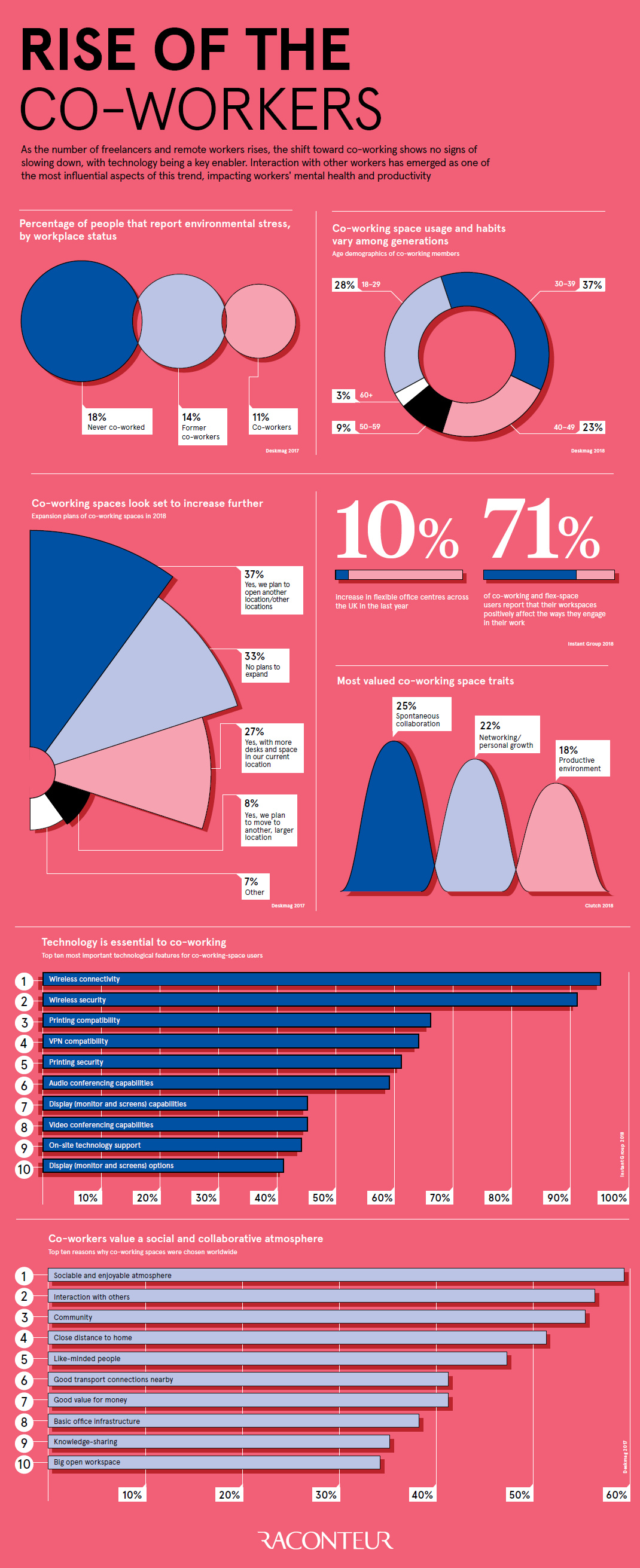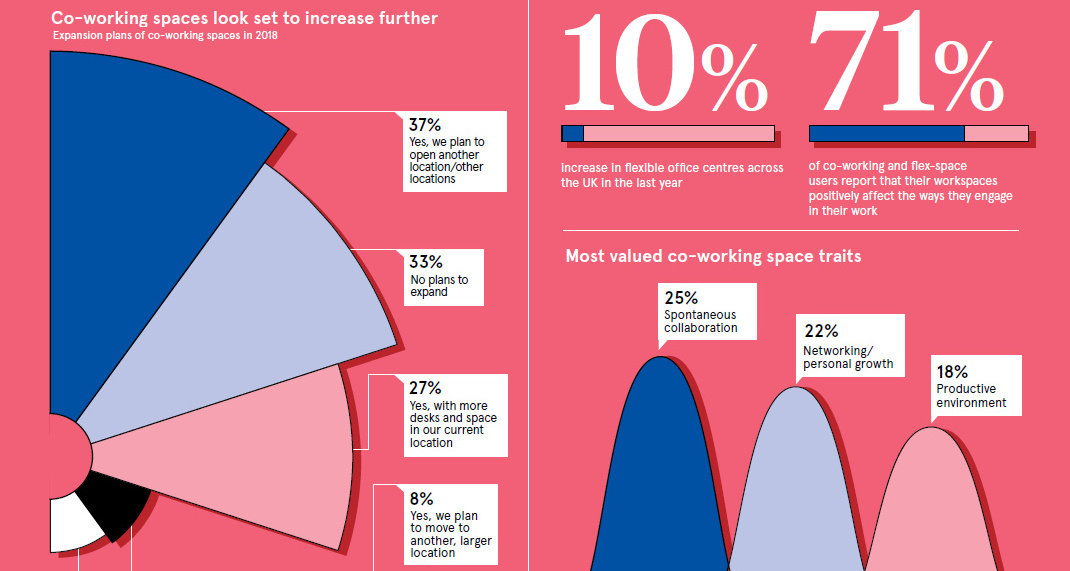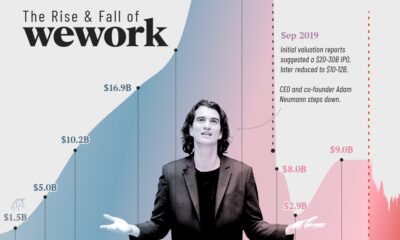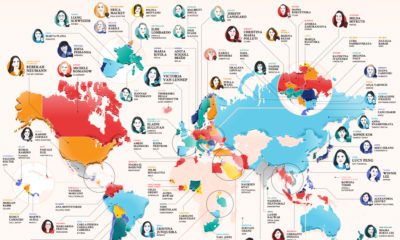Technology
Visualizing the Rise of Co-Working Spaces

Visualizing the Rise of Co-Working Spaces
In the modern era, people can work from anywhere and everywhere.
Thanks to the cloud, wireless protocols, and collaboration software, it’s possible for workers to be productive from a nearby coffee shop, another town, or a different country entirely.
While this unprecedented freedom allows us to work further apart, it’s simultaneously enabled a new business model that brings people together. The rise of co-working spaces – led by companies like WeWork – is already a multi-billion dollar industry, and a growing mainstay of startup culture.
Co-Working Together
Today’s infographic comes to us from Raconteur, and it shows why companies – and especially fast-growing startups – are increasingly gravitating towards co-working spaces.
The co-working industry offers something to startups that traditional solutions cannot, which is the ability for office space to scale with the company’s growth both seamlessly and flawlessly. Further, by covering all the essentials, from working wireless internet to an unlimited supply of coffee, this new model allows startups to focus on what matters, such as achieving product-market fit or the latest pivot.
The industry is expected to grow at a 12% CAGR over the next five years, and there’s even talk that segment-leading WeWork will be raising money at a $35 billion valuation.
Beyond the Value Prop
The prospect of “Space-as-a-Service” is certainly a compelling one for fast-growing startups, but what other valid reasons factor into the momentum behind co-working spaces?
According to co-workers themselves, here are the ten highest-ranking benefits of the model:
- Social and enjoyable atmosphere (59%)
- Interaction with others (56%)
- Community (55%)
- Close distance to my home (51%)
- Like-minded people (47%)
- Good value for money (41%)
- Good transport connections nearby (41%)
- Basic office infrastructure (38%)
- Knowledge-sharing (35%)
- Big open workspace (34%)
All in all, the value added by co-working spaces seems to be very real for the companies that call these shared spaces home.
As a result, it will be no surprise to learn that the global co-working industry is expected to expand to 30,432 spaces and 5.1 million members by 2022.
Technology
Visualizing AI Patents by Country
See which countries have been granted the most AI patents each year, from 2012 to 2022.

Visualizing AI Patents by Country
This was originally posted on our Voronoi app. Download the app for free on iOS or Android and discover incredible data-driven charts from a variety of trusted sources.
This infographic shows the number of AI-related patents granted each year from 2010 to 2022 (latest data available). These figures come from the Center for Security and Emerging Technology (CSET), accessed via Stanford University’s 2024 AI Index Report.
From this data, we can see that China first overtook the U.S. in 2013. Since then, the country has seen enormous growth in the number of AI patents granted each year.
| Year | China | EU and UK | U.S. | RoW | Global Total |
|---|---|---|---|---|---|
| 2010 | 307 | 137 | 984 | 571 | 1,999 |
| 2011 | 516 | 129 | 980 | 581 | 2,206 |
| 2012 | 926 | 112 | 950 | 660 | 2,648 |
| 2013 | 1,035 | 91 | 970 | 627 | 2,723 |
| 2014 | 1,278 | 97 | 1,078 | 667 | 3,120 |
| 2015 | 1,721 | 110 | 1,135 | 539 | 3,505 |
| 2016 | 1,621 | 128 | 1,298 | 714 | 3,761 |
| 2017 | 2,428 | 144 | 1,489 | 1,075 | 5,136 |
| 2018 | 4,741 | 155 | 1,674 | 1,574 | 8,144 |
| 2019 | 9,530 | 322 | 3,211 | 2,720 | 15,783 |
| 2020 | 13,071 | 406 | 5,441 | 4,455 | 23,373 |
| 2021 | 21,907 | 623 | 8,219 | 7,519 | 38,268 |
| 2022 | 35,315 | 1,173 | 12,077 | 13,699 | 62,264 |
In 2022, China was granted more patents than every other country combined.
While this suggests that the country is very active in researching the field of artificial intelligence, it doesn’t necessarily mean that China is the farthest in terms of capability.
Key Facts About AI Patents
According to CSET, AI patents relate to mathematical relationships and algorithms, which are considered abstract ideas under patent law. They can also have different meaning, depending on where they are filed.
In the U.S., AI patenting is concentrated amongst large companies including IBM, Microsoft, and Google. On the other hand, AI patenting in China is more distributed across government organizations, universities, and tech firms (e.g. Tencent).
In terms of focus area, China’s patents are typically related to computer vision, a field of AI that enables computers and systems to interpret visual data and inputs. Meanwhile America’s efforts are more evenly distributed across research fields.
Learn More About AI From Visual Capitalist
If you want to see more data visualizations on artificial intelligence, check out this graphic that shows which job departments will be impacted by AI the most.
-

 Markets1 week ago
Markets1 week agoU.S. Debt Interest Payments Reach $1 Trillion
-

 Markets2 weeks ago
Markets2 weeks agoRanked: The Most Valuable Housing Markets in America
-

 Money2 weeks ago
Money2 weeks agoWhich States Have the Highest Minimum Wage in America?
-

 AI2 weeks ago
AI2 weeks agoRanked: Semiconductor Companies by Industry Revenue Share
-

 Markets2 weeks ago
Markets2 weeks agoRanked: The World’s Top Flight Routes, by Revenue
-

 Countries2 weeks ago
Countries2 weeks agoPopulation Projections: The World’s 6 Largest Countries in 2075
-

 Markets2 weeks ago
Markets2 weeks agoThe Top 10 States by Real GDP Growth in 2023
-

 Money2 weeks ago
Money2 weeks agoThe Smallest Gender Wage Gaps in OECD Countries







